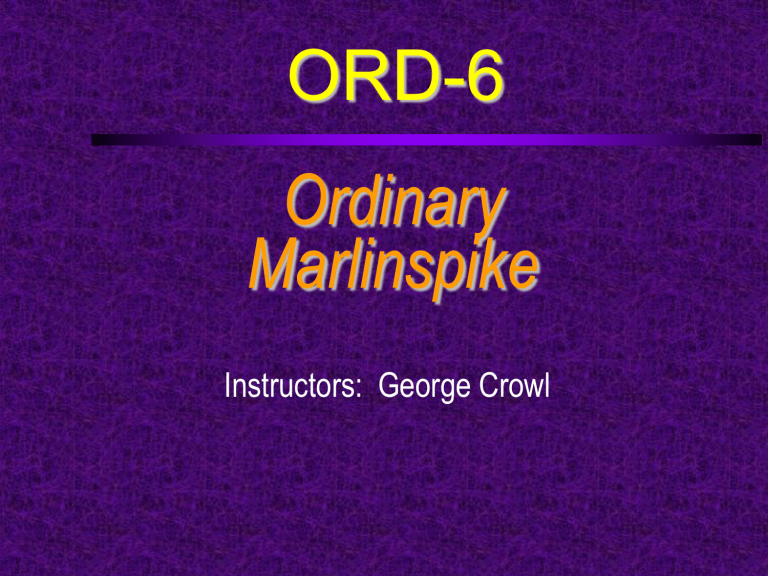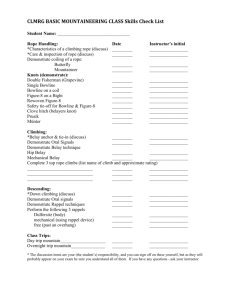ORD-6: Marlinspike

ORD-6
Ordinary
Marlinspike
Instructors: George Crowl
Course Outline
a. Name the various materials used to manufacture rope, the advantages and disadvantages of each, and the characteristics of laid and braided rope.
Discuss the meaning of lay, thread, strand and hawser. Explain how rope is sized and measured.
Course Outline
b. Using both large and small lines, tie and explain the following knots: stevedore's knot, French
(double) bowline, bowline on a bight, timber hitch, rolling hitch, marline hitch, and midshipman's (taut line) hitch. c. Demonstrate your ability to secure a line to pilings, bitts, cleats, and rings, and to coil, flake, and flemish a line.
Course Outline
d. Demonstrate how to cut and heat-seal a synthetic line and whip the end of plain-laid line using waxed cord or similar material.
ORD-6a
a. Name the various materials used to manufacture rope, the advantages and disadvantages of each, and the characteristics of laid and braided rope.
Discuss the meaning of lay, thread, strand and hawser. Explain how rope is sized and measured.
Rope Materials – Natural
Cotton – cheap, weak, not shock absorbent (clothsline). Woven or laid. NOT to be used nautically.
Sisal – inexpensive, weaker than manila. Must dry, will rot, laid.
Manila – best natural material.
Expensive. Must dry, will rot, laid.
Minimum stretch. ¼” = 600# test.
Rope Materials – Synthetic (1)
Polyethylene – floats, chafes, no rot, sunlight deteriorates rapidly, ¼” = 1200# test
Polypropylene – floats, no rot, sunlight deteriorates rapidly, slightly stronger, resists oil
Dacron (polyester) – minimum stretch (9%), better for sheets & halyards, no rot, oil resistant, usually woven, ¼” = 2400# test
Rope Materials – Synthetic (2)
Nylon – maximum stretch (20%), best for anchoring and towing.
Oil, chemical, abrasion resistant.
Sunlight resistance good.
¼” = 1800# test. Usually woven.
Samson Amsteel – Proprietary new material,
4% stretch, sunlight resistant, woven,
¼” = 8600# test = steel
Laid Rope
a. Slivers b. Slivers of fiber twisted in one direction = yarn c. Yarns (3) twisted in opposite direction = strand d. Strands (3) twisted in opposite direction = rope e. Rope twisted in opposite direction = hawser
Laid Rope Info
Normally three strands
Normally right-handed
Cable-laid – three ropes laid together
Hawser – any rope over 5” circumference
Can be four strands with heart
Braided Rope
Core surrounded by fully-sheathed braid protects core
Braided core
Stranded core
Core provides strength
Braid provides protection from
Abrasion
Sunlight
Rope Sizing
Normally sized in diameter up to 2”
3/16, ¼, 5/16, 3/8, 7/16, ½, etc.
Then sized in circumference (3.14 x dia)
Old times, all nautical rope was sized in circumference, but no more.
5” hawser is circumference, should be about 1.6” diameter!
7” rope is a bit over 2” in diameter
Rope Length
Rope in store – normally FEET or METERS
Could be in fathoms (6 feet)
Coil of rope usually:
100 fathoms (land)
200 fathoms (nautical)
ORD-6b
b. Using both large and small lines, tie and explain the following knots: stevedore's knot,
French (double) bowline, bowline on a bight, timber hitch, rolling hitch, marline hitch, and midshipman's (taut line) hitch.
Good Animated Web Site
www.animatedknots.com
If the link does not work, just type in the link separately, or go to animatedknots.com
Stevedore's Knot
Stopper knot
Make loop
Wrap 1½ times
End through loop
Pull tight
Stevedore Animated
www.animatedknots.com/stevedore/#Movie
French (Double) Bowline
Start as a regular bowline (right)
Run line around the loop again (right)
Bring line up through hole as with regular bowline
(middle)
Bring line around back, down through hole, as a regular bowline
Pull knot tight
(left)
French Bowline Animation
Can't find
Bowline on a Bight
Make a bight (big, long loop in line)
Start it just like a bowline
Bring the end of the loop down and around the big loop
(or feed big loop through)
Slide the loop end up and adjust all to fit need
Loops hold same size
Bowline on a Bight Animation
http://www.animatedknots.com/bowlinebight/
Timber Hitch
Run a line around a timber, leaving 6”-1' left
Bring the bitter end around the standing end, and tuck it back on itself
Tuck a minimum of three times, tighten
You may want to put a half hitch around the towed end for a big or long timber
Timber Hitch Animation
http://www.animatedknots.com/timber/
Rolling Hitch
Wrap one full time around
Wrap a second full time around
Cross over the two lines
Come under the crossover line
Tighten
Pull along the length of the pole (down)
Rolling Hitch Animated
https://www.youtube.com/watch?v=OX_kU_jYecU
Marline Hitch
Start with a clove hitch around boom(s) and sail
Space out 1-2 feet, hold, and put a half hitch
Insure the half hitch goes in on top and out the bottom
Cover the whole sail (or other long skinny object)
Tie off with clove hitch or to something else
Midshipman's (Taut Line) Hitch
Pass line over the bar or line you are tying to
Bring it down, around, and in between your line and the bar.
Make a second loop in between
Continuing the same direction, cross over the two loops, wrap once
Slide under your wrap, tighten
Midshipman's Hitch Animation
http://www.animatedknots.com/midshipmans/
ORD-6c
Demonstrate the ability to secure a line to pilings, bitts, cleats and rings and to coil, flake and Flemish a line.
Cleat
Know from Apprentice
Full turn around cleat to start
Remember – parallel ropes under cross rope
Do not add many loops!
Bitts
Seldom seen in some parts of US
Eye splice / bowline OR wrap around far bitt
Cross to near bitt
Repeat several times on each bitt
Used on large vessels and shore installations
Piling
Piling – big tall post, often in water
Use a fixed knot – eye splice or bowline
Temporary – two half hitches or midshipman hitch
Don't use clove hitch or other knot that slips under constant movement
Rings
Lines are attached to rings semi-permanently by larks-head knots in an eye splice.
Use a bowline, or midshipman's hitch
Coil a Line
Right hand, even loops
Half twist as you coil
Save two loops to finish
Wrap around middle
Finish with bight through top
Coiling Animation
http://www.animatedknots.com/coiling/
Flake a Line
Used to make a line run out without kinks
Take the kinks out of the line, beginning at where it pulls from
Start at the other end, lay figure 8s on the deck
Each 8 is on top, and slightly closer to the payout side
Flake a Line
http://www.animatedknots.com/fig8flake/
Flemish a Line
Shake the line out so it is not twisted
Turn the bitter end in a small circle
Keep the line flat on the deck
Use two hands as the circle gets bigger
If needed, coil the line instead
Flemish Animation
The author prefers Plan B.
http://www.animatedknots.com/flemish/
ORD-8b
Demonstrate how to cut and heat-seal a synthetic line, and whip the end of a plain-laid line using waxed cord or similar material.
Cut and Heat Seal
Synthetic line should be cut and heat sealed
“Guns” and “knives” do both at once – best
Can use knife and lighter
Keep end small to go through blocks
Common Whipping (1)
Lay a bight along rope
Start wrapping tightly from end of rope
When whipping length = rope diameter, slide cord end through bight
Pull bight under whipping about half way
Trim the ends
Common Whipping (2)
Make a large loop of twine
Lay one end 1” over the end of the line, the other end 2-3” down the rope
Start wrapping tight from the rope end
Wrap at least the diameter of the rope
Pull the twine at the end of the rope until it pulls the loop
½ way under the whipping
Trim the ends



